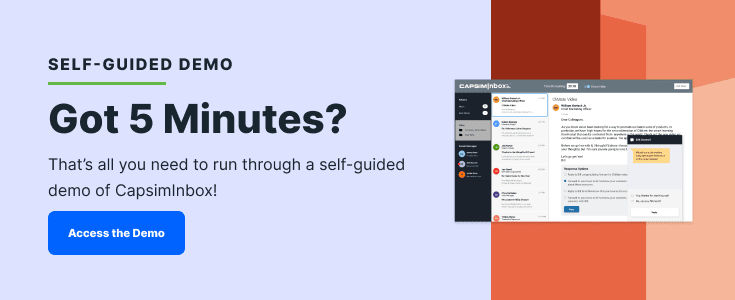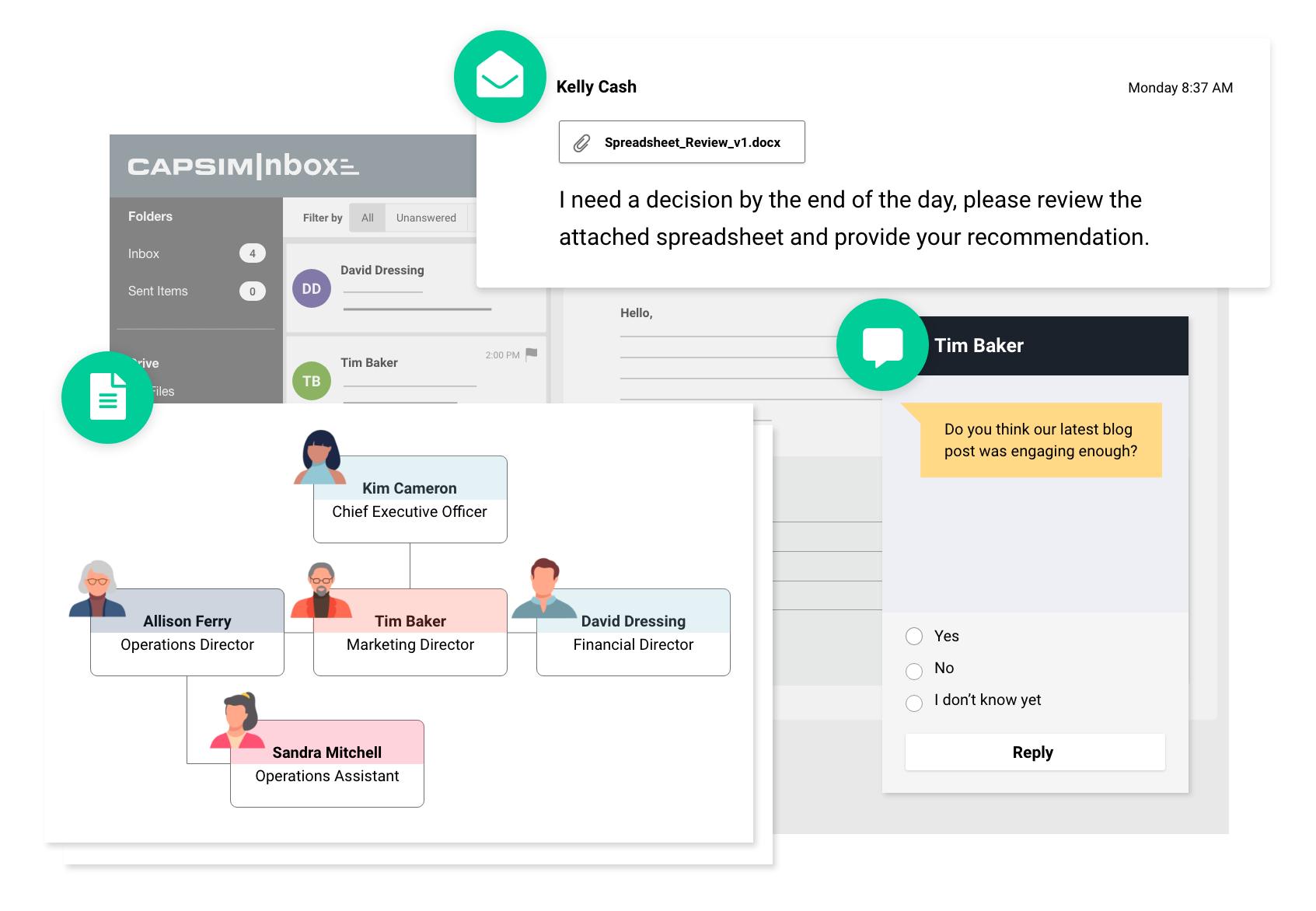Top Business Soft Skills Competencies (And How To Measure Them)
June 7, 2022
.jpg)
“Close only counts in horseshoes and hand grenades.”
And since L&D is not either of those things, “close” doesn’t get the kind of results that help your company achieve its goals. This is particularly true when measuring employee business soft skill competencies.
These skills can determine whether an employee is a good cultural fit and are a huge indicator of potential as a high-impact employee. So you see why being close isn’t ideal when assessing business soft skills. You need to be accurate.
This post will discuss which business soft skills are most important, why they’re important, and why it’s equally important to measure them accurately.
Finally, we’ll show you how to do it using inbox simulations.
Business Soft Skills (and Knowing How to Measure Them) are Crucial for Organizational Success
Why are soft skills important? Soft skills are about more than just people skills (though those are important as well). Soft skills encompass a broad range of organizational, emotional, and analytical skills that help with job performance, leadership, customer interactions, and more.
Let’s examine some of the evidence of the importance of soft skills.
- A 2018 LinkedIn study identified developing soft skills as the #1 priority for companies.
- A separate 2019 LinkedIn survey found that 92 percent of hiring and talent professionals said soft skills matter more than hard skills.3
- A 2021 America Succeeds analysis showed the top five soft skills were requested nearly 4X more than the top five hard skills across 82 million job postings.
In short, the importance of soft skills can’t be understated. Cultivating the right soft skills is vital to the success of your organization, which means your L&D department needs to have a reliable way to assess, measure, and train business soft skills.
Assessing soft skills can help your organization make great hiring decisions, identify future leaders, and spot candidates for upskilling and reskilling for new roles in your organization.
Top Business Soft Skills Competencies
Some of the top business soft skills employers want in 2022 include:
- Communication:
Communication is about more than presentation skills. This soft skill refers to an employee’s ability to express their ideas clearly, effectively relay information, and actively listen to the ideas of others. - Team-Building:
Teamwork and collaboration are essential, to some degree, in every business. Employers are looking for workers capable of working with their colleagues to tackle challenges and projects. - Problem-Solving:
Problem-solving refers to a person’s ability to analyze a problem, devise and evaluate possible solutions, and implement the best option to solve the problem. Though collaboration is necessary, employees need to be able to think critically on their own. - Time Management:
Time management has always been an essential skill in business, but it's more vital in the post-2020, increasingly-remote-or-hybrid work environment than ever. Employers need workers who can manage their schedules and complete tasks on time. - Flexibility:
As a rule, people don’t like change. Unfortunately, the business world doesn’t like to stand still. As a result, employers need workers who can adapt to changes in the workplace.
Traditional Methods for Measuring Business Soft Skills are Flawed
We’ve established the importance of soft skills in the workplace, but how do you effectively measure soft skills? There are three methods traditionally used for measuring business and leadership soft skills. Let’s take a look at each in turn and examine the strengths and weaknesses of each approach.
Assessments
Assessments or questionnaires are among the most commonly used methods of measuring soft skills. Using an assessment, you will create a list of prompts such as “I am comfortable being the mediator in an argument,” or “I take time to analyze situations before responding.”
Employees will then respond to the prompts using a scale, rating their agreement from “strongly agree” to “strongly disagree.”
This method is appealing because it is easy to implement at scale and provides measurable numerical results. However, soft skills assessments are not without their drawbacks.
Employees taking these assessments can lie about their agreement to the statements or provide coached answers. Even an honest employee may not represent their soft skills accurately, as self-assessment is inherently biased and subjective.
Role-Playing
Another method you can use to measure business soft skills is role-playing. In a role-playing exercise, you will stage a scenario and request an employee or multiple employees to act out their response to the scenario in question. You, as the trainer, will observe the role-play and assess their actions.
This method is good in theory, as it removes the self-assessment bias and the ability to lie or provide coached answers. However, role-playing scenarios take a significant amount of time to set up and implement. As a result, this method is challenging to implement at scale.
Behavioral Interviews
Lastly, you can implement behavioral interviews. In a behavioral interview, an interviewer will ask employees open-ended questions to encourage the interviewee to share real-life stories. Ideally, these stories give the interviewer insight into the employee’s proficiency in various soft skills.
A positive of this type of measurement method is it requires the interviewee to provide details regarding their answers, unlike the assessment. This addition makes it more difficult for the employee to lie or falsely represent their skill level.
The downsides to behavioral interviews are numerous, however. Interviews can also be studied or coached. A Google search for “situational interview questions” returns thousands of results—many providing the “correct” answer to the prompt. Additionally, interviewers bring subjectivity and personal biases to the interview that can skew the employee’s results.
Creating Different Measures for Each Business Soft Skill is Exhausting
Traditional methods of soft skill measurement are less than ideal, so perhaps the solution is to implement unique measures for each business soft skill. By tailoring the measurement to the unique skill in question, your team can accurately assess employee skills gaps and proficiency, right?
Perhaps, but let’s take a moment to evaluate the time and effort this undertaking would require.
Related Read: 4 Innovative Ways Companies are Using Soft Skill Training for Employees
Imagine you want to assess time management. What steps would you need to take to measure this one skill effectively? Your steps may look something like this:
- Establish clear time-management-related goals.
- Create a tracking method to accurately track how each employee spends their time during the workday.
- Establish check-in procedures and confirm those procedures with management.
- Hold regular meetings or checkpoints with project stakeholders to track progress.
- Set a timeline for goal completion and devise methods of calculating results based on the tracking methods established in step two.
Your process would likely have even more steps than this, but here’s the kicker: Time management is likely not the only soft skill you need to measure. The effort you’ve put into devising a tracking and measurement system for time management would then need to be multiplied across all the soft skills you’d like to measure.
Add in the time spent manually tracking each employee’s progress on each soft skill listed, and you have an unmanageable amount of work on your hands, no matter how large your L&D department is.
An Easier Way to Accurately Measure Your Employees’ Business Soft Skills
We’ve spent a lot of time discussing the difficulties of measuring business soft skills competencies. Now it’s time to show you the simple, accurate way to measure your employees’ soft skills.
Your measurement method must reflect the skill at hand to measure soft skills accurately. It cannot be a self-assessment or someone else's assessment, as these methods are biased. Instead, you must use an objective test.
Enter inbox simulations.
Inbox simulations are the perfect tool for measuring business soft skills. Every CapsimInbox simulation begins with a self-assessment of skills. Then, the employee can participate in a simulation that allows them to put those soft skills to the test in a real-world environment. The simulation provides an objective measure of their skills.
Once they have completed the simulation, the employee will be able to compare their self-assessment to their actual business soft skill competencies. This knowledge will make them aware of gaps between their perceived and actual competencies, providing them the self-awareness they need to engage in further training.
The real-world nature of the simulations makes the results objective and accurate, allowing the employee to make real decisions they could encounter on the job in a controlled, measured environment.
Inbox simulations are simple to implement at scale and allow you to measure performance over time, showing growth in employee performance. In conjunction with other instructional methods, inbox simulations can aid in knowledge retention, engagement, and more.
Measuring Business Soft Skills Competencies
Investing in the training and development of soft skills is vital to the success of your organization. When your workforce has the right organizational, emotional, and analytical skills, they can collaborate more effectively, provide better service to your customers, work more independently, and make more measured decisions.
To determine if your workforce has the soft skills they need to help your business thrive, you need to be able to measure and evaluate those skills accurately. Using biased, self-assessment-reliant, and resource-heavy methods of measuring is inefficient at best and ineffective at worst. The good news is that you can measure soft skills digitally using inbox simulations.
CapsimInbox’s simulations enable your employees to make a day’s worth of decisions in thirty minutes. Your L&D department can easily measure the simulation results, provide immediate feedback, and help your staff grow in ways that count.
See what your employees would see by taking our five-minute self-guided demo today!





.png?width=80&name=1-questions%20(1).png)